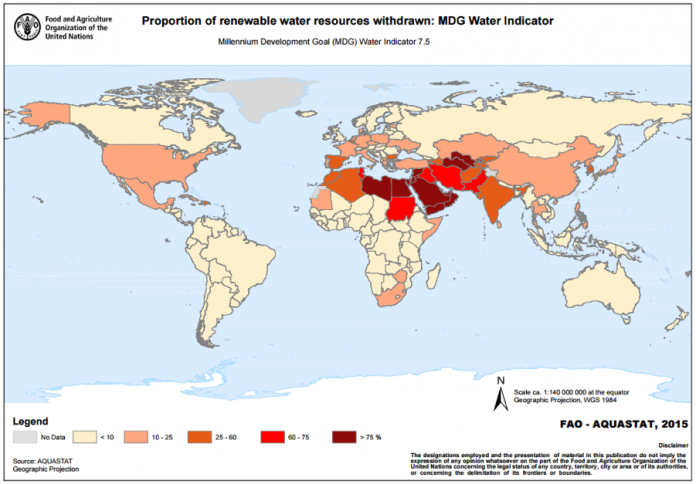How reliable, verifiable information impacts global decisions
*Third interview in Aqua-Statisticians: A five part series

Marisha Wojciechowska-Shibuya: How has AQUASTAT data shaped public policy-making?
Karen Frenken: AQUASTAT numbers are frequently quoted in policy dialogues, scientific journals, global reports, and advocacy campaigns. Our data has enabled a better picture in each country of how much water is available, withdrawn, used, treated, and returned to the system.
AQUASTAT’s impact is to provide the secure data foundation on which any national, regional and global level analyses will stand.

For the Millennium Development Goals, AQUASTAT monitored the indicator on the “Proportion of renewable water resources withdrawn” (see map).
Now that Goal 6 of the Sustainable Development Goals deals specifically with water, AQUASTAT has been nominated to work with the countries on the monitoring of target 6.4: “By 2030, substantially increase water-use efficiency across all sectors and ensure sustainable withdrawals and supply of freshwater to address water scarcity and substantially reduce the number of people suffering from water scarcity”.
AQUASTAT remains the only global, reliable and verifiable dataset and information system on water issues that is freely available to all. It represents more than 60 percent of all visits to the entire FAO Water website with constant updates through AQUASTAT’s RSS Feeds and Twitter account.
Indeed, I know of no significant report related to water that does not depend to some extent on data provided by AQUASTAT. Significantly, a fifth of all queries come from countries seeking data about their own country.
To reach non-water specialists, our “Info for the media” lets people quickly find facts and figures about water resources, their uses, and irrigation. Our infographics and visualizations like this demonstrate, for example, how AQUASTAT reveals national dam capacities around the globe and for which more detailed information on each dam is provided in accompanying Excel files:

Through such uses, the AQUASTAT data steers policy debates, helps identify data-gaps, determine policy priorities and demonstrate the importance of water in this age of competing interests and needs.









